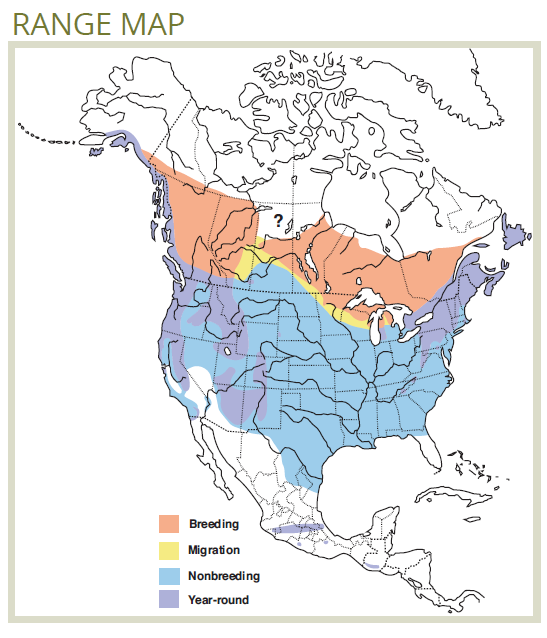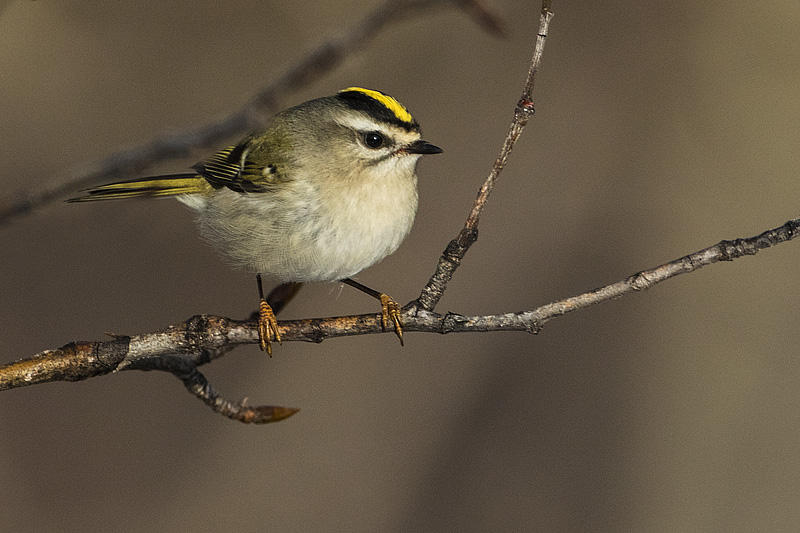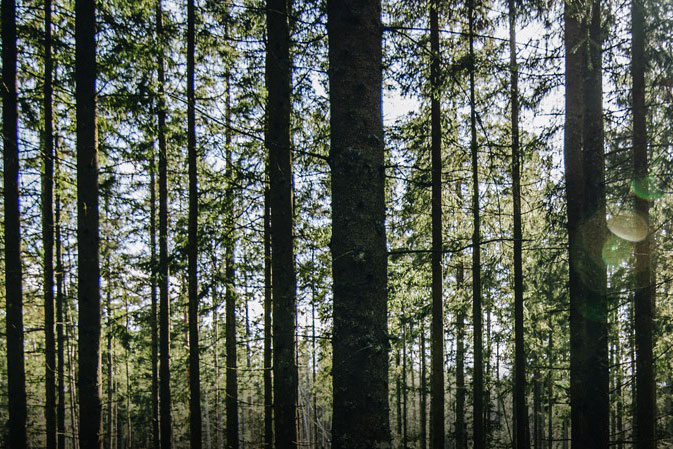This small, round songbird is a familiar sight in many coniferous forests, where its high-pitched song sounds like a tiny car trying (unsuccessfully) to start.
Golden-crowned Kinglet
(Regulus satrapa)
Habitat Ecology
- The Golden-crowned Kinglet is associated with old, dense conifer forests including Douglas fir, western hemlock, mountain hemlock, and spruce.1 It is also common in spruce-aspen mixedwood forests from >75 years2 to >140 years old.3

Response to Forest Management
- This species’ close association with forests older than rotation age makes it highly sensitive to harvest. It was absent from stands up to 33 years following clearcutting1,4 and declined following harvests with 20–70% retention,1,5 smallscale harvests including uniform single-tree removal,6 and moderate to heavy thinning.7,8
- Riparian buffers >30–35 m may support higher occupancy than narrower buffers ≥10 years postharvest.9–11 Varying buffer widths with wider areas serving as retention anchors may benefit this species.
- Golden-crowned Kinglet abundance increases in areas of mountain pine beetle, spruce beetle, and spruce budworm infestation.1
Stand-level Recommendations
- Retention harvest is overall considered less effective than old forest stands or set-asides, given this species’ declines even in harvested blocks with very high retention. The retention of features including large-diameter conifers will, however, likely improve the structural complexity and long-term habitat value of regenerating stands.
- Riparian buffers >30–35 m wide may help support this species, however they will likely occur at lower densities than in unharvested forest.12
Landscape-level Recommendations
- The primary strategy for conserving this species is the maintenance of conifer-dominated forest stands exceeding the rotation age on the landscape.
- Large continuous stands and/or strong connectivity among stands, as would occur under an NRV scenario, will likely be of higher quality than fragmented or isolated forest patches, as this species has shown edge sensitivity13 and reluctance to cross gaps >25 m wide.14
References
- Swanson, D. L., Ingold, J. L. & Galati, R. 2012. Golden-crowned Kinglet (Regulus satrapa), version 2.0. in The Birds of North America (Rodewald, P. G., ed.) Cornell Lab of Ornithology, Ithaca, New York, USA. Available online: https://doi.org/10.2173/bna.301
- Schieck, J. & Song, S. J. 2006. Changes in bird communities throughout succession following fire and harvest in boreal forests of western North America: literature review and meta-analyses. Canadian Journal of Forest Research 36: 1299–1318. Available online: https://doi.org/10.1139/x06-017
- Cumming, E. E. & Diamond, A. W. 2002. Songbird community composition versus forest rotation age in Saskatchewan boreal mixedwood forest. The Canadian Field-Naturalist 116: 69–75. Available online: http://www.biodiversitylibrary.org/item/109250
- Leston, L., Bayne, E. & Schmiegelow, F. 2018. Long-term changes in boreal forest occupancy within regenerating harvest units. Forest Ecology and Management 421: 40–53. Available online: https://doi.org/10.1016/j.foreco.2018.02.029
- Lance, A. N. & Phinney, M. 2001. Bird responses to partial retention timber harvesting in central interior British Columbia. Forest Ecology and Management 142: 267–280.
- Leupin, E. E., Dickinson, T. E. & Martin, K. 2004. Resistance of forest songbirds to habitat perforation in a high-elevation conifer forest. Canadian Journal of Forest Research 34: 1919–1928. Available online: http://www.nrcresearchpress.com/doi/10.1139/x04-057
- Hayes, J. P., Weikel, J. M. & Huso, M. M. P. 2003. Response of birds to thinning young Douglas-fir forests. Ecological Applications 13: 1222–1232. Available online: http://dx.doi.org/10.1890/02-5068
- Bayne, E. M. & Nielsen, B. 2011. Temporal trends in bird abundance in response to thinning of lodgepole pine (Pinus contorta). Canadian Journal of Forest Research 41: 1917–1927. Available online: http://www.nrcresearchpress.com/doi/10.1139/x11-113#.Wftr0NCnFzB
- Pearson, S. F., Giovanini, J., Jones, J. E. & Kroll, A. J. 2015. Breeding bird community continues to colonize riparian buffers ten years after harvest. PLoS ONE 10: e0143241. Available online: https://doi.org/10.1371/journal.pone.0143241
- Pearson, S. F. & Manuwal, D. A. 2001. Breeding bird response to riparian buffer width in managed Pacific Northwest Douglas-fir forests. Ecological Applications 11: 840–853. Available online: http://www.jstor.org/stable/3061120
- Hagar, J. C., Howlin, S. & Ganio, L. 2004. Short-term response of songbirds to experimental thinning of young Douglas-fir forests in the Oregon Cascades. Forest Ecology and Management 199: 333–347.
- Hagar, J. C. 1999. Influence of riparian buffer width on bird assemblages in western Oregon. The Journal of Wildlife Management 63: 484–496. Available online: http://www.jstor.org/stable/3802633
- Hejl, S. J., Mack, D. E., Young, J. S., Bednarz, J. C. & Hutto, R. L. 2002. Birds and changing landscape patterns in conifer forests of the north-central Rocky Mountains. Studies in Avian Biology 25: 113–129. Available online: https://www.researchgate.net/profile/Richard_Hutto/publication/267211708…
- Rail, J.-F., Darveau, M., Desrochers, A. & Huot, J. 1997. Territorial responses of boreal forest birds to habitat gaps. The Condor 99: 976–980. Available online: http://www.jstor.org/stable/1370150








